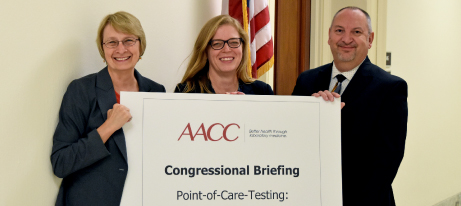
Point-of-care testing (POCT) is poised to grow into a $30 billion industry worldwide by 2020, promising novel innovations that swiftly deliver results on routine and molecular laboratory tests. However, some roadblocks related to quality and reimbursement are stifling its path, according to POCT experts who spoke during an AACC-sponsored briefing Oct. 3 on Capitol Hill. To reach this technology’s full potential for serving patients, speakers James Nichols, PhD, DABCC, FADLM, Kerstin Halverson, BA, MS and moderator Patricia Jones, PhD, DABCC, FADLM, urged support for policies that would strengthen access to POCT while ensuring their safety and effectiveness.
POCT makes up just one-third of all lab tests, yet this modality is growing by 8-9% per year, according to Nichols, professor of pathology, microbiology, and immunology and medical director of clinical chemistry and point-of-care testing at Vanderbilt University in Nashville, Tennessee. The market “has nearly doubled since 2008,” expanding from $13.1 billion to $20.2 billion worldwide, he noted.
At least 78,000 clinical testing sites in the United States now offer POCT, and facilities that operate with limited oversight now represent 71% of all clinical laboratory testing sites, Jones said in her opening remarks.
POCT is changing the delivery of care on several fronts, said Halverson, clinical applications manager for acute care diagnostics at Instrumentation Laboratory in Bedford, Massachusetts. The technology is used “pretty much everywhere”— from physicians’ offices and accident scenes, to ambulances and homes. Timely results mean that patients receive diagnoses quickly and move on to treatments faster, she said, using the rapid strep test as a prime example. At-home use enables patients to self-monitor their results and decrease the need for frequent clinic visits, affording them more independence. POCT also has the capacity to lower emergency department visit lengths of stay and streamline medical interventions at major accidents, Halverson said. “POCT has also been correlated with a reduced need for follow-up visits and wider access to healthcare in remote areas,” she added.
In his projections of how POCT is evolving, Nichols described a world in which smartphone apps would allow physicians to analyze and deliver results for glucose, urinalysis, and pregnancy. In addition, molecular POCT is being developed for infectious diseases such as Clostridium difficile, respiratory viruses, and sexually transmitted infections. Designed so users with minimal training can operate them, these tests aren’t just the next wave in doctors’ offices—disaster relief initiatives, military operations, and even schools could benefit from molecular POCT, Nichols added.
What POCT currently lacks is a sound regulatory framework and a reimbursement structure, according to the speakers. Most POCT devices are not subject to federal oversight calling into question the quality of these tests, Nichols said. CLIA-waived laboratories only have three requirements: to agree to unannounced inspections, to follow device manufacturers’ instructions, and to pay a biennial fee for their certificate.
As CLN reported earlier this year, the Centers for Medicare and Medicaid Services (CMS) used to conduct spot surveys to help labs identify and correct issues related to POC devices. However, the agency stopped those inspections in 2016, despite the growing number of sites offering POCT, Nichols said. To follow up on what CMS started, he urged the Department of Health and Human Services’ Office of the Inspector General (OIG) to investigate the quality of testing at Certificate of Waiver sites to ferret out any needed improvements and provide recommendations.
OIG should specifically assess the quality of testing at these sites both in aggregate and by type of facility (e.g. physician office, pharmacy, nursing home, etc.), and determine the financial impact of any identified problems on Medicare and Medicaid, Nichols advised.
Reimbursement cuts under the Protecting Access to Medicare Act of 2014 (PAMA) poses another conundrum for the POCT market. PAMA’s market-based fee schedule is based on private sector fees that reflect figures at high-volume reference labs instead of sites that conduct waived tests. “This hits POCT very hard,” due to the high cost of performing these tests, explained Nichols.
Unlike large reference labs, which can order their reagents in bulk and do thousands of tests a year, performing one POC test for a one-time user is much more expensive, Nichols told CLN Stat. With PAMA’s cuts projected to reduce reimbursement by $9.9 billion over 10 years, many labs may no longer see POCT as a cost-effective venture. Common POC tests have already been cut. Reimbursement for prothrombin time tests, with approximate costs of $6.50, has dropped from $5.39 in 2017 to $4.37 in 2019. For lipid panels, reimbursement has declined from $18.37 in 2017 to $14.88 in 2019. Overall, “gaps between reimbursement and costs are increasing,” remarked Nichols.
AACC is supporting a bipartisan bill sponsored by Rep. Scott Peters, D-Calif. that seeks to ensure the accuracy of PAMA’s fee schedule, Nichols said. Specifically, it would delay by 1 year the next collection cycle to give new labs time to gather and report information on their payment data. It would also commission the National Academy of Medicine to conduct a study on ways to improve the data collection process, ensuring that rates are based on real-world costs.